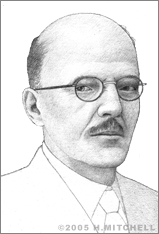Hans Geiger
Nuclear physicist Hans Geiger, whose surname is known all over the world for his invention of the radioactivity measuring device known as the Geiger counter, was born Johannes Wilhelm Geiger in Neustadt-an-der-Haardt, Germany on September 30, 1882. He was one of five children born to Wilhelm Ludwig Geiger, a philosophy professor at the University of Erlangen.
Geiger studied physics at the University of Munich and, later, at the University of Erlangen, where he completed his doctoral degree in 1906. He then moved to England to work at the University of Manchester with the renowned British scientist Ernest Rutherford, who won a Nobel Prize for Chemistry in 1908.
With Rutherford, Geiger conducted research related to radioactivity that would prove to be critical to the field’s advancement. In 1910, for example, Geiger and colleague J. M. Nuttall developed the Geiger-Nuttall rule, which states that a linear relationship exists between the logarithm of the range of alpha-particles and the radioactive time constant, which is involved in the rate of decay of emitting nuclei. Geiger was also involved in a number of experiments that led to Rutherford’s breakthrough theory of the atom, which declared that the nucleus occupies a very small volume at the center of every atom.
In 1911, also while working with Rutherford, Geiger created a measuring device that had the ability to count the number of alpha particles and other ionizing radiation being emitted. This was the first version of the Geiger counter. A Geiger counter generally uses a sealed, gas-filled, metal tube that acts as an electrode. A thin wire or needle along the middle of the tube acts as a second electrode, and a voltage is applied to the device such that a current can almost pass through the gas from one electrode to the other.
Whenever the counter nears a radioactive substance, the gas becomes ionized, and the ionized gas particles are then able to carry the current in a complete circuit, from one end to the other. When this phenomenon occurs, the device measures each passing particle, usually via an electronic mechanism that is set up to produce audible “clicks” for each of the ionized particles by amplifying the current. The tool may also measure ionization using a pointer and scale; this is called a rate meter.
Geiger counters may be used to detect cosmic rays and locate radioactive minerals. The tool has a number of scientific and medical applications. For example, it even allows one to check materials for radioactivity in the home if the presence of radon is suspected in your basement.
In 1914, Geiger left England and returned to Germany to oversee radiation research at the Physikalisch-Technische Reichsanstalt (German National Institute for Science and Technology). He subsequently served as an artillery officer with the German Army during World War I. After the war, he returned to research and directed radiation laboratories at the University of Kiel from 1919 to 1928, the University of Tübingen from 1919 to 1936, and finally, at the Technische Hochschule in Berlin.
While working at the University of Kiel in 1928, Geiger worked to improve the Geiger counter with fellow physicist, Walther Müller. The pair improved the device’s sensitivity, performance, and durability. The new version was dubbed the Geiger-Müller counter, and today the men share credit for creating a tool that laboratories around the world rely on to this day. (In recent years, Geiger counters have been replaced for some applications by more complex tools, such as scintillometers.)
Geiger died in Berlin on September 24, 1945 at the age of 62.


